Hostetler Truck Trailers
Explore our inventory of trailer types for your truck or utility vehicle
From utility truck add-ons to skid steer loaders, we offer one of the largest varieties of trailer types in Pennsylvania. Shop our extensive trailer styles below, including deckover, enclosed, and other popular options!
Trailer Types
Tell us about your ideal trailer. We’ll find the type to make it a reality.
This webpage will help you through the process of selecting your ideal truck trailer by providing information about several categories of trailer types, all of which are carried by Hostetler Truck Bodies and Trailers.
You can also explore our FAQ section. Here, you’ll find an index of commonly asked questions about truck trailers as well as useful links to related vendor websites. If you have any unanswered questions along the way, please reach out to our team on our Contact Us page. For more information on custom manufacturing services for trucks, please visit this page to get a quote.
types of trailers
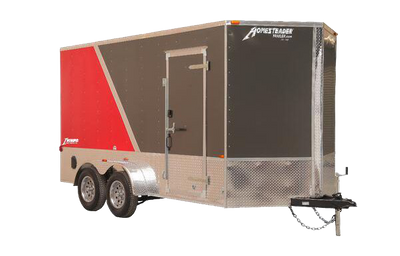
ENCLOSED TRAILERS
An enclosed trailer is generally characterized by its aluminum exterior and interior steel frame, but this trailer type — often referred to as a “dry box on wheels” — may also be identified by its access doors (found on the sides and in the rear of the trailer), as well as by its notable height, which allows most average adults to stand fully and comfortably upright.
All enclosed trailers must be road legal and in accordance with state and city driving regulations. However, this parameter varies widely from one location to the next. In a similar war, enclosed trailers may have many potential specifications and individual quirks when it comes to their carrying capacity. Ultimately, the trailer manufacturer and trailer model can “make” all the difference.
In recent years, the most common designs of truck and car trailers have evolved, and today, the industry finds that most drivers and consumers prefer the "V-nose" as their chosen trailer nose style. That being said, a traditional radius front is still better suited for many commercial applications.
Enclosed trailers are generally constructed with a steel frame and an aluminum exterior.
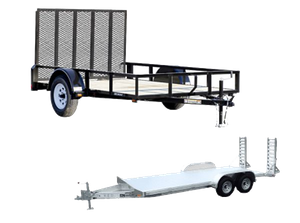
UTILITY TRAILERS
Utility trailers are one of the lighter and more spacious types of trailers. They can be found in a wide variety of sizes and are listed according to a broad spectrum of price ranges.
Depending on the towing application, these trailers can be customized with numerous accessories provided by individual manufacturers, such as Homesteader, Moritz, Belmont, and more. When you choose to partner with our professional crew at Hostetler Truck Bodies & Trailers, you’re sure to find a utility trailer available that can fit each and every tow job — and accommodate any budget.
Contact a Hostetler sales representative to find the ideal blend of functionality and styling in your next trailer for trucks, large work vehicles, and more.
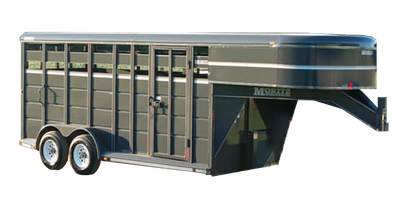
LIVESTOCK/HORSE TRAILERS
Horse trailers vary in size depending on the number of animals requiring transportation. However, two-horse trailers are the most common — or, at least, the most common livestock trailer request we get here at our Milroy truck upfitter.
Livestock trailers are commonly known to feature a center slam gate, a structure designed to divide the trailer into seven- to eight-foot-long sections. The length generally ranges from a minimum of 16 feet to an average maximum of 45 feet. Typically, a horse trailer is constructed to be 7’ or 21 hands in height; however, some livestock trailers fall just shy of these dimensions, standing around 6'6".
Here at Hostetler Truck Bodies & Trailers, we offer livestock trailers by reliable regional suppliers from various locations in relation to our Milroy business. Talk to a Hostetler team member about trailer sizes, styles, options, and delivery times available at our Milroy truck upfitter when you contact us today.
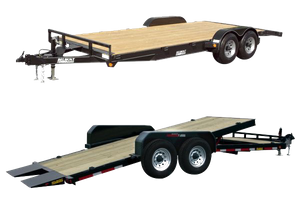
SKID STEER TRAILERS & SKID LOADER EQUIPMENT
Most professionals who own a skid steer loader and visit our Milroy upfitting shop are looking for a supplementary trailer. We often hear requests for skid steer trailers that are low to the ground, extremely durable, and afford a considerable amount of room for attachments. Skid loader trailers — an alternative name for skid steer trailers — come in a variety of styles, sizes, and modes of functionality. When you shop at Hostetler Truck Bodies & Trailers in Milroy, you can be certain you’ll find an ideal skid steer trailer to conform to the specifications of your utility loader’s required level of stability.
A popular category of skid loader trailer is the tilt trailer, which is designed for rapid off-loading of its cargo through the use of a tilt mechanism. Skid loader tilt trailers are commonly available in lengths from 16 to 24 feet. This style of trailer may include a cushion cylinder, allowing it to tilt more smoothly.
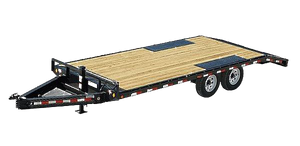
DECKOVER TRAILERS
A deckover trailer is designed with the wheels underneath, permitting the greatest possible unrestricted loading width. Deckover trailers are ideal for loading small excavators and backhoes, rollers, pallet material, tractors, and other larger cargo.
Deckovers are usually sold in single-wheel configurations for loads under 16,000 lbs or twin (dual)-wheel configurations for loads up to 24,000 lbs. Common loads include:
Backhoes
Larger Bobcats
Mini-Excavators
Pavers
Pallet Materials
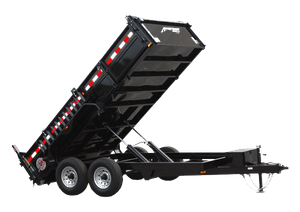
DUMP TRAILERS
A dump trailer is defined by the presence of an electric hoist which will tilt the trailer bed up to a 45-degree angle, quickly and easily removing the contents without the effort and time customarily associated with unloading.
Dumps are becoming more common as they can also perform tasks similar to an equipment or utility trailer, making a dump trailer the closest thing to a universal trailer.
Dump trailers mainly come in two styles:
Deckover
Low-profile
A deckover (DO) dump would be a dump with the wheels tucked underneath the bed, saving the approximately 18-inch width of a set of fenders, and making the overall width about a foot narrower than a low profile, sitting up about four to six feet higher than most industry standards.
Deckover dump trailers are one of the most nimble and navigable trailer types for trucks. Drivers find ease in maneuvers such as parking in the street, driving on busy roads, and even when negotiating narrow clearances. This type of trailer can be a bit more top heavy (a.k.a. “tippy”), but it definitely does a better job of dumping and transporting material piles. As an added bonus, this trailer variety has the advantages of being lighter and less expensive than the leading low-profile dump trailer models.
A low-profile (LP) dump trailer refers to a dump with the wheels outside of the frame, making the trailer lower to the ground with a wider stance. This makes the trailer very stable, and its low stance makes it ideal for loading equipment. A low-profile dump is generally about 18" wider overall than the box size.
Regardless of trailer type, for larger loads, gooseneck hitch configurations like the one pictured above are recommended for towing stability and improved turning radius, and are most common in lengths ranging from 25 to 32 feet.
Recommended Vendor Websites



A Word About Towing
What's your GVWR?
Manufacturers will provide a Gross Vehicle Weight Rating (GVWR) for the vehicle you are using to pull.
This number is not its towing capacity, but rather represents a maximum value of what your vehicle can safely weigh including payload. This would include the tongue weight of the trailer, which is the amount of the trailer weight that is distributed to the tow vehicle. The remaining trailer weight rests on its axles.
For example, your truck may have an 'empty' weight of 5,500 pounds (often called a “curb weight”) and a GVWR of 7,000 pounds. This means that you can safely add an additional 1,500 pounds of passengers, cargo, and tongue weight without exceeding the GVWR.
Gross Combined Vehicle Weight Rating (GCVWR)
The GCVWR is how automakers list the maximum allowable weight a vehicle can tow, and is defined as the maximum weight of a loaded vehicle AND its attached loaded trailer. And like the other weight ratings, the vehicle’s manufacturer calculates this number.
For example, if a truck’s GCVWR is 14,000 pounds and it has a base curb weight of 5,000 pounds, that means the vehicle can safely handle an extra 9,000 pounds of cargo and trailer weight. However, it doesn’t matter (to a certain point) where that cargo is placed. If a passenger weighing 200 pounds sits inside the truck, that 200 pounds has to be subtracted from the truck’s then-available GCVWR. Owners must be mindful not to exceed the GVRW and/or the GCVWR.
Automakers usually publish tow ratings that account for a driver and one passenger, each weighing 150 pounds, and a full tank of fuel. So, if you’re going to tow a trailer that weights exactly what your vehicle is rated to pull, you’d better leave the family and their luggage behind. Continuing with the example, if a truck has a 15,000-pound GCVWR and it weighs 6,000 pounds empty, plus it’s loaded with 4,000 pounds of cargo and passengers in the bed and cab, it can pull a trailer weighing no more than 5,000 pounds.
Please contact your vehicle manufacturer if you have any questions regarding the GVWR / GCVWR for your vehicle.
